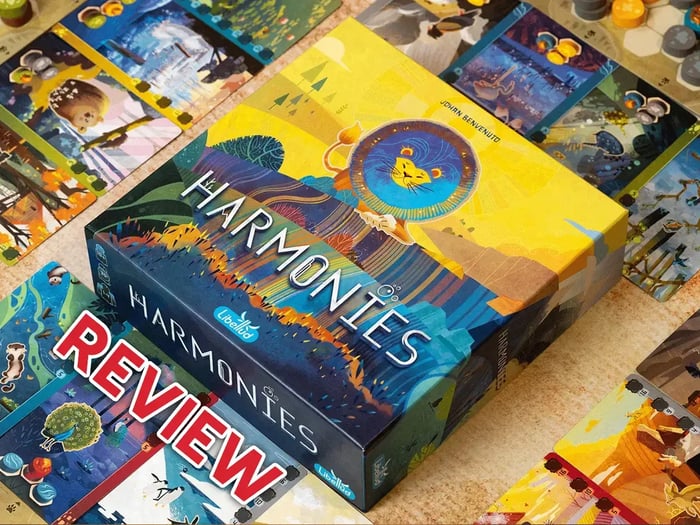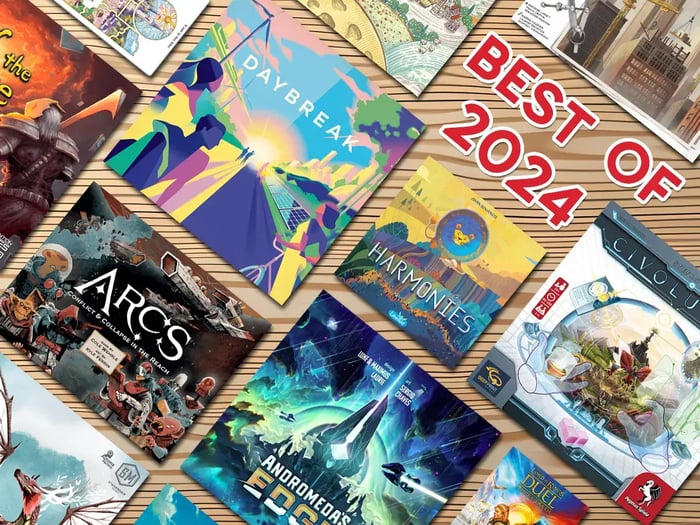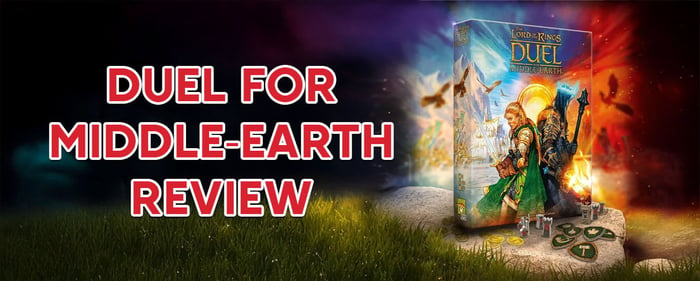Building habitats the way the animals like them
Table of Contents
This is a game where every well thought through choice you make feels like a strategic masterclass of clever terrain planning.
Every token you place incorrectly stares at you for the rest of the game, acting as the downfall of your perfectly planned penguin dream.
You will find yourself calculating the most efficient placements of trees only to see every token drawn to be stone or water or worse.
You’ll watch your opponent smile sweetly as they take the 3 tokens from the board that would have completed your board like an artist applying the finishing touches to their canvas.
This is Harmonies. You will love it and feel the frustration of the draft in equal measures.
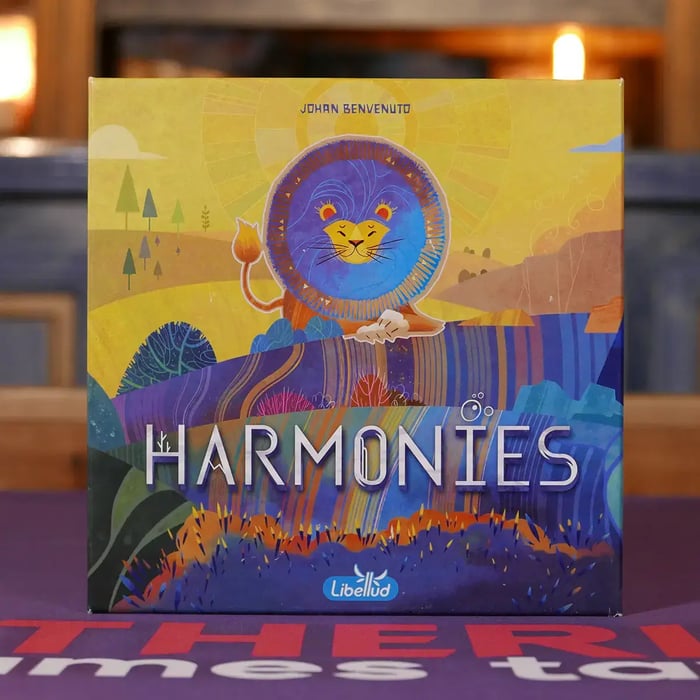 Harmonies Box Art
Harmonies Box ArtMechanics: Open drafting, tile placement, pattern building, animals, multiple scoring options, abstract, desperately waiting for a green tile to complete your tree only to watch your opponent pick it up
Players: 1 - 4
Best at: 2-3
Playing time: 30 - 45 mins
Age: 10+
Overview
Being the most Harmonious!
But you will definitely come back for more.
Harmonies is a game about creating habitats. You place coloured tokens in a way that attracts different types of animals to your personal board. Each type of animal is worth a number of points based on how many you are able to place.
Throughout the game, you will use a combination of tokens to create rivers, trees, mountains, buildings and fields. As well as being used to meet the criteria to place animals, these terrain types also have their own point-scoring rules.
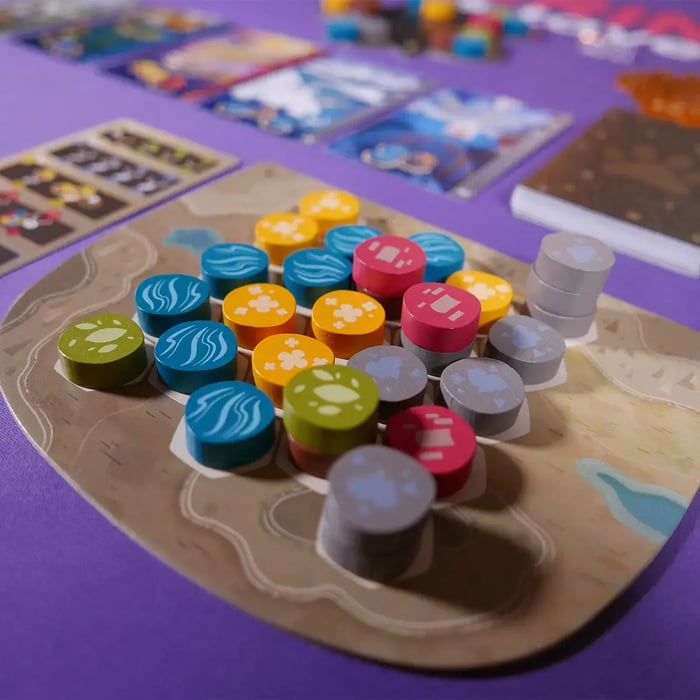 The personal board in Harmonies
The personal board in HarmoniesThe winner is the player with the most points at the end of the game.
Harmonies is an abstract game in the same space as games like Cascadia. Some comparisons have been drawn, as they both feature different terrain types and animal placement, but they are ultimately very different games.
Let's have a look at the game and its mechanics and see if it's any good. Spoiler: it's excellent!
Gameplay
So how does it work?
In Harmonies, each player starts the game with a double-sided game board, each with slightly different scoring mechanics.
Side A is recommended when you first play the game and leads you to score water as part of the river. Side B is when you are playing the ‘islands’ variant. I will explain these in more detail later.
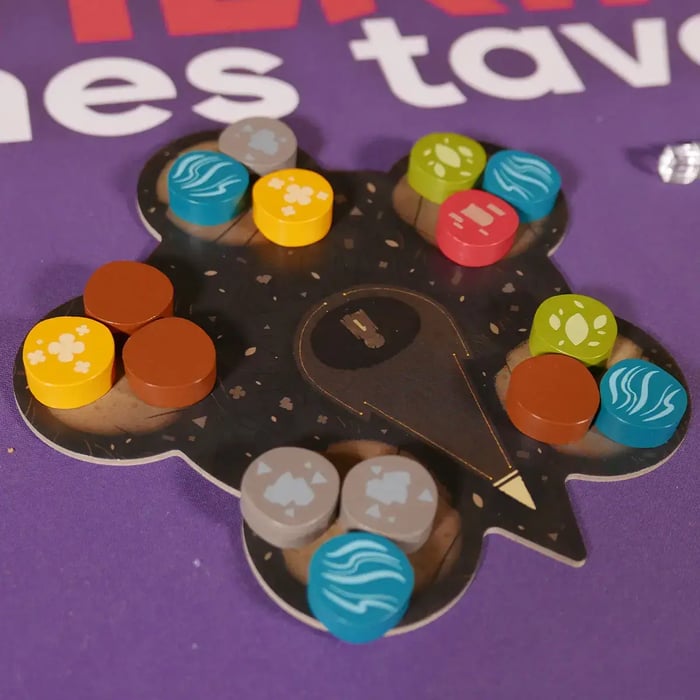 The central board in Harmonies
The central board in HarmoniesIn the centre of your table, you place the central board. On this, you add three random tokens from the bag to each of the five spaces.
The central mechanic of Harmonies is around drafting the tokens from the central board. On your turn, you must choose one space on the board and take all tokens from that space.
This might mean a difficult decision as you may desperately need green tokens but not have anywhere to place yellow tokens, so choices have to be made.
Once you have chosen your tokens, they must be placed on the board, either in an empty space or stacked on top of each other. For this, there are certain placement rules in order to make the different terrain types.
In Harmonies, you use your tokens to create a lovely 3D landscape on your personal game board, which is a great mechanic and looks very pretty!
After placing tokens, you have the option to take one animal card from the face-up cards available. Throughout the game, there will be five cards available in the middle of the board. These are replaced from the deck of 32 different cards as taken.
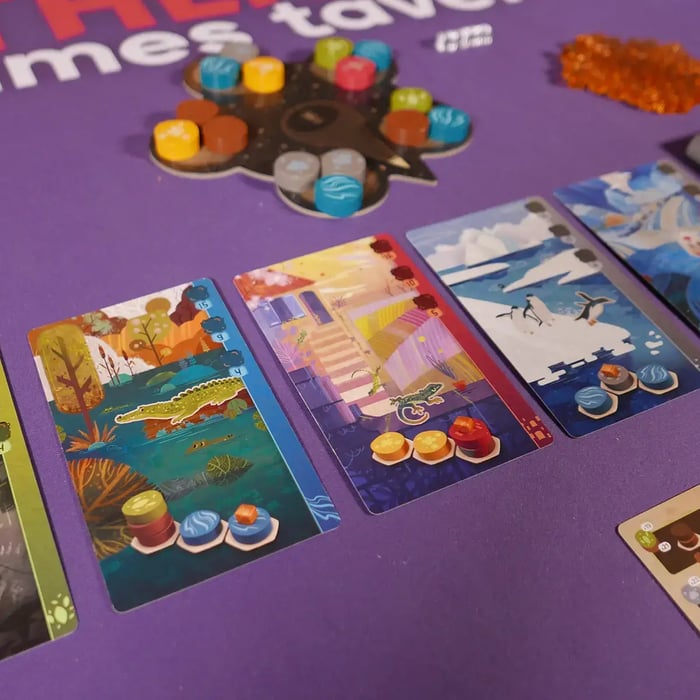 The animal row in Harmonies
The animal row in HarmoniesEach animal card is unique, featuring a different combination of terrain tokens needed to place a cube on the board. They also have a number of spaces for animal cubes that you collect from the supply when you take a card, giving you the maximum number of animals you will place of that type.
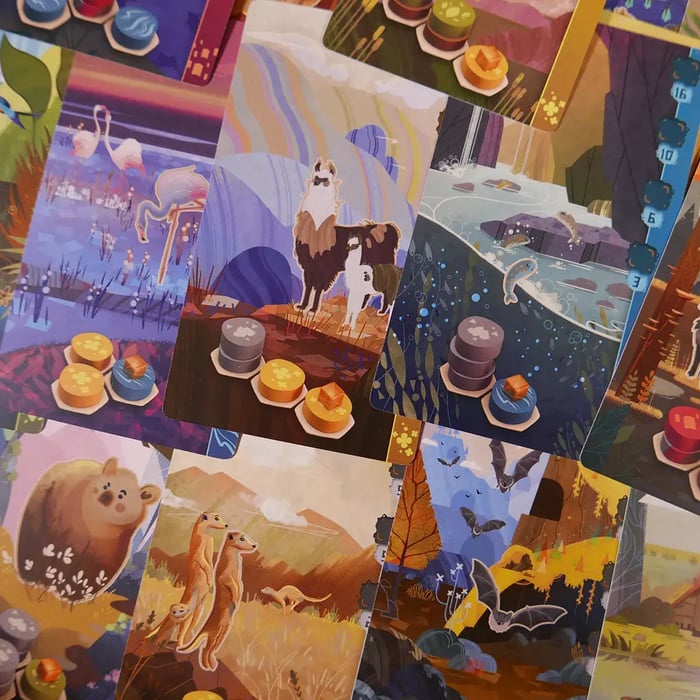 Animal cards in Harmonies
Animal cards in HarmoniesFinally, each card scores uniquely depending on how many cubes you move from the card to your board. It also shows you where the animal cube must be placed.
This is really important, as only one cube can be placed in each space. In order to put more than one cube out you have to recreate the pattern required for each cube, though terrain tokens can be shared for the purpose of creating more than one pattern.
As an example, a mouse card shows that you need a building between two yellow tokens. Once you have created this pattern you can place one cube on the building. At the end of the game, one cube placed is worth 5 points, but if you place all three, it's worth 17.
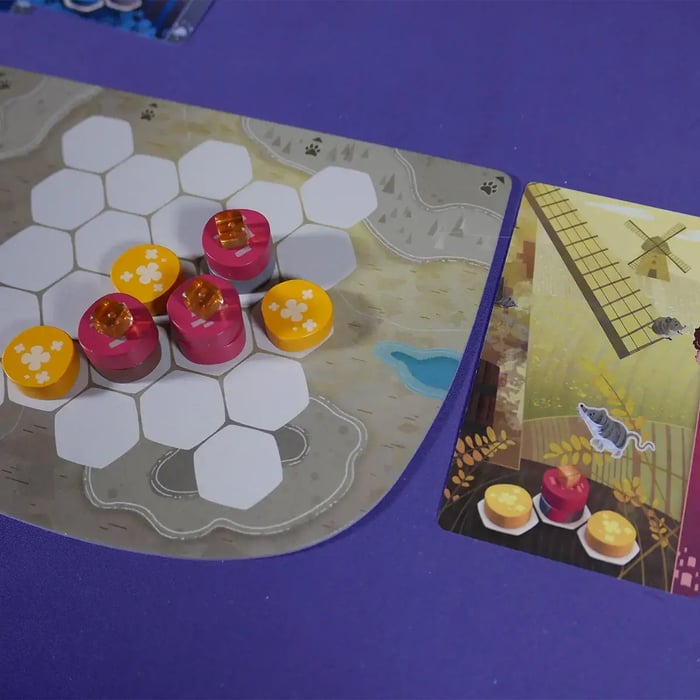
You can have up to 4 active animal cards in front of your board, giving you multiple options and helping you to focus on a certain strategy. This is especially true if you can collect animals that are looking for a similar terrain combination.
Once you have placed all cubes on an animal card, you put the card in a face-down scoring pile, freeing up a space for another animal card.
Scoring
So, let's talk about these coloured tokens
In harmonies, there are six different tokens:
Grey, representing mountains
Red, which helps create buildings
Brown and green are both used for trees
Blue for water
Yellow is used to create fields.
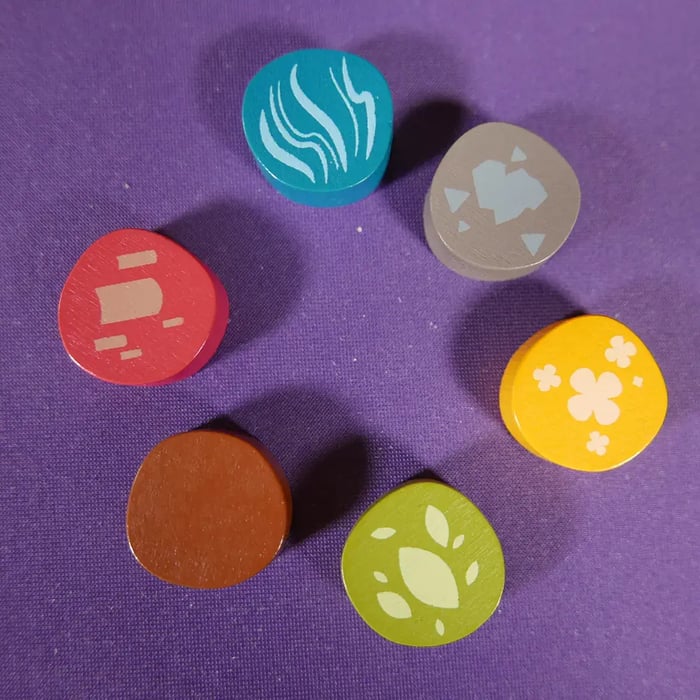 One of each coloured token in Harmonies
One of each coloured token in HarmoniesIn addition to colour, each token has a unique pattern on the top. This brings a nice design but also provides accessibility by not only using colours. This could impact some playing the game, so credit goes to the designers for including this!
As previously mentioned, a token can either be placed into an empty space or stacked to create a terrain type.
Each terrain type has unique placement rules. A tree can be a single green token in a space, a brown token topped with a green token, or it can even be 2 brown tokens topped with a green token.
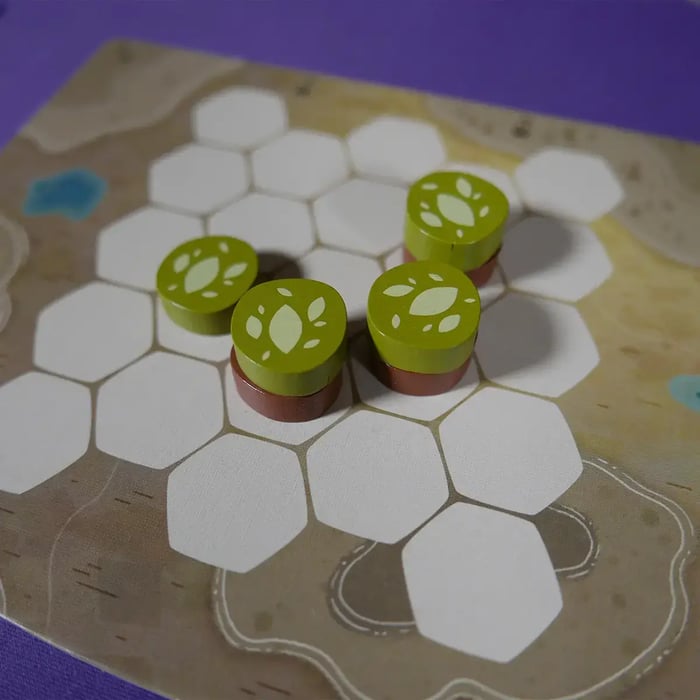
The heights are significant for two reasons. Each terrain has unique scoring criteria. Trees score more depending on their height.
In addition to the scoring, different animals might require different tree heights to meet their criteria. So you have to make choices based on potential scoring opportunities and on which animals you are trying to place!
Mountains are similar to trees. They can be stacked up to 3 high but will only score at the end of the game if they are adjacent to another mountain.
Buildings can be either a red, grey or brown base token with a red building token on top. These score as long as there are at least 3 unique tokens around them.
Yellow tokens are not stacked but score per group of 2 or more yellow tokens.
Finally, Blue tokens (i.e. water tokens) score in 2 different ways. If you play the riverside, you score for the longest line of blue tokens. On the Island side, you score for each individual section of land separated by water.
This is the real challenge of this game. It is not as simple as placing tokens in the right places but needing the right combination of tokens to create the terrain you need.
As well as that, you are trying to place them in the right patterns in order to place animals and maximise your terrain score at the end of the game.
The frustrating truth about token placement
On your turn, you select a space and draft three randomly drawn tokens from the central board.
On some turns, these will provide you with the perfect combination of tokens you have been looking for to create the terrain you need, and there will be great joy.
On many turns, however, this will contain one, maybe even two, tokens you don’t want or need.
This creates a dilemma of how best to use those tokens. In an ideal scenario, these will work towards another animal card or help you create higher-scoring terrain combinations. Still, each token placed will also potentially limit future plans and frustrate you later.
It goes without saying that once a token is placed, it doesn’t move! Instead, that yellow token that you just ‘had to place’ will smile at you whilst occupying the perfect space for a tree later!
Finally, the frustrating truth about token placement is that before you know it, and certainly before you are ready, it will trigger the end of the game.
Usually, this will happen about 2 turns earlier than you needed in order for you to complete your perfect terrain.
Ending The Game
Please, just one more turn...
The game ends in one of 2 ways:
If there are no tokens left in the pouch to fill the central board or, and most frustratingly…
When at least one player has 2 or fewer empty spaces left on their personal board.
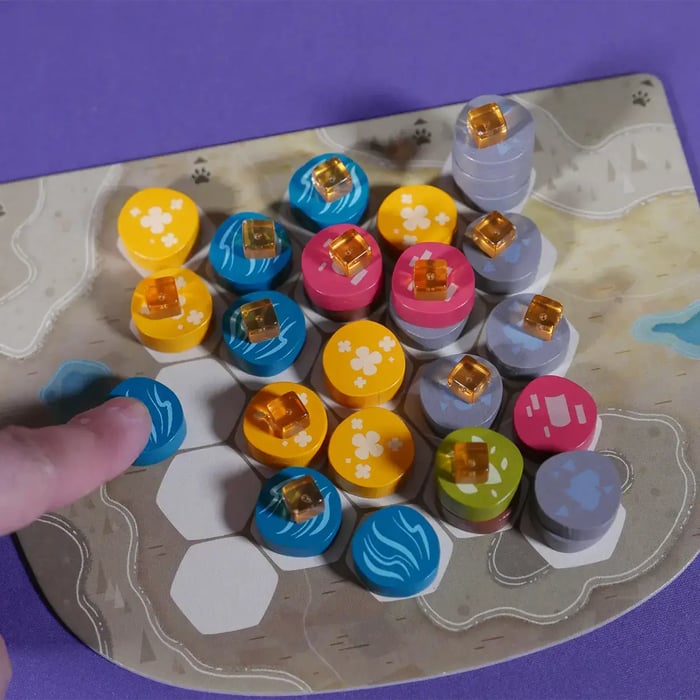
Players then complete their turns until all players have had equal turns!
This creates a different tension. You need to keep one eye on other players to ensure you are not caught out by the game ending sooner than you expected.
Sometimes, you catch yourself out as you draft tokens you are unable to place and fill up your few remaining spaces without realising you were that close!
Points are then totalled based on terrain and then animal cards. The player with the highest points total wins!
Is it any good?
Perfect harmony or a clanging gong of a game?
In my opinion, Harmonies is a well-designed abstract game. It brings a beautiful sense of designing and creating your personal board as you draft in tokens and expand your terrain.
There is something about these kinds of games where you place tiles/tokens to create patterns that really appeal to me. There is a profound sense of satisfaction and a feeling of completion.
This game really lives up to its name in this sense. As you get the right tokens for the board you are curating, you feel like you are creating something harmonious.
Like many of these drafting games, this is matched by the feeling of frustration. Often, the token pools and the spaces on the central board do not exactly match your needs.
You are often making compromising choices. “I really need that red token to complete my building, but I have no use for those grey ones!”.
You are left trying to work out the best strategy, balancing and building the habitats you need to attract animals in the most efficient way. Being able to adapt your strategy and not having all your eggs in one terrain-shaped basket is fairly key!
There is also a great strategy in choosing the animals. Looking for animals that share some terrain features can bring real benefits as you can bring more benefits with less work.
This can lead to challenges. So often, I was building out a perfect habitat only to lose my brain temporarily and add a different animal to the feature, causing me problems later!
This can also be a real problem, as you may not have the space or may not be able to draft the tokens to start again.
Remember, once you place an animal on a terrain feature, that space is taken.
So if you need a stack of 3 mountains next to a field to place an eagle on top and you accidentally fill it with something else, you have to build another stack of 3 mountains, probably through gritted teeth mumbling how annoyed you are with yourself!
Harmonies as a game has a lot of replayability straight out of the box.
With 32 animal cards, most games will only see a smaller selection of the animals in the deck. Each of the animals requires completely unique terrain patterns, but they often share some elements.
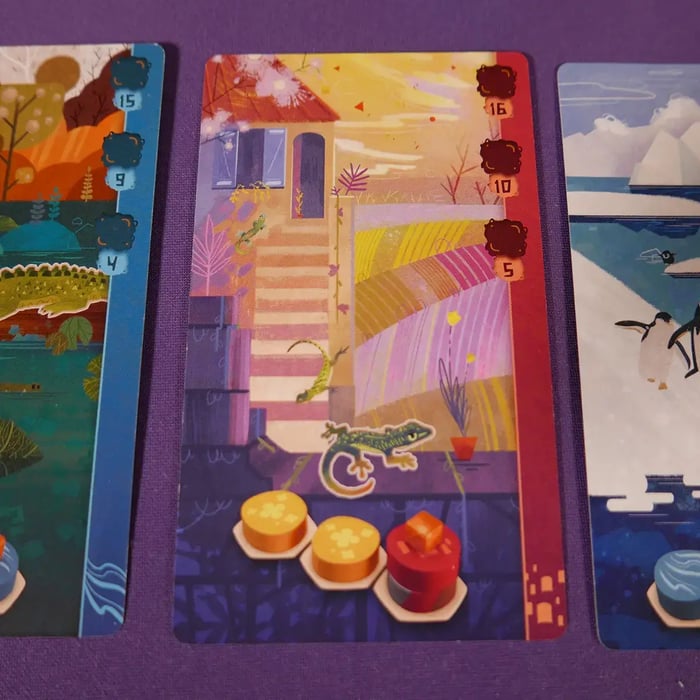
This creates different combination strategies depending on which animals are revealed. No two games will ever be the same, and the terrain strategy you had for one will not help in the next.
On top of this, you can focus more on the terrain scoring strategies. For example, a long river or a well-built mountain range can make a huge difference.
Even the side of the board you use makes the game very different. Using the island variation makes the blue tokens and the board layout incredibly different again and can be a whole different brain burner!
Replayability
What about the spirit animals?
Something we have not talked about is the Nature Spirit cards!
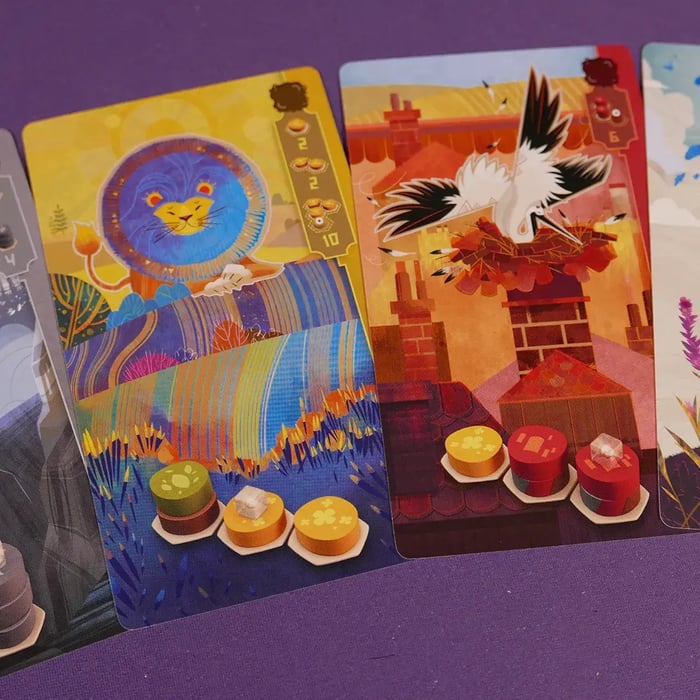 Spirit animal cards in Harmonies
Spirit animal cards in HarmoniesOnce you have played a few games of harmonies you have the option of adding in the Spirit cards. These give each player a unique spirit card that they start the game with and fill one of the 4 animal slots on your player board.
These are placed on the board in the same way by building out a specific terrain pattern. These cards do not have a victory point value but provide enhanced or unique terrain scoring opportunities.
For example, if you place the spirit owl on your board, bushes (single stack green tokens) score one in the normal terrain scoring phase but then score 3 for each bush on the board with the owl.
Again, this provides new strategies. If you have the owl you would then proactively look for animals that require single green tokens in their habitats to maximise the scoring potential!
This brings even more replayability with 10 different Spirit Nature cards available.
Final Thoughts
Harmonies is, in my opinion, a brilliant game.
It’s beautifully designed with nice tactile tokens and lovely artwork on the animal cards. The gameplay is simple to learn, so it is really easy to teach and accessible to younger players and families.
It also has great replayability and strategic challenges that appeal to all gamers.
This is going to really appeal to people who enjoy those tactile token-drafting / tile-placement style games such as Cascadia or Azul or similar games.
On the downside, it does bring with it that frustration of just not being able to draft the tokens you need, depending on what has been pulled at random from the bag.
This is mitigated by having 5 spaces to choose from, but you can still be sitting willing just one red token to come out of that bag only to see your opponent gleefully draft it.
The other aspect some will not enjoy is the lack of player interaction.
Aside from competition for tokens from the central board and animal cards available, you are working on your own personal board. This, like many others in this category, is a race to gain the most points on your own board before the game's end is triggered.
Harmonies has been a real hit for me, and it has filled the gap for a solid, fairly light-weight, well-designed game with a short playtime of around 30 minutes.
With no 2 games the same, I am always really happy to play. And with a simple teaching, you can easily be introduced to new players.
Review Score
8/10
| Pros | Cons |
| + Simple well-designed game that is easy to teach and pick up | - Like all drafting games, random token drafting can be frustrating and leave you unable to complete the terrain you want |
| + Nice token drafting system | - Low player interaction will not appeal to all. |
| + Brilliant terrain creation mechanic as you combine different tokens in a 3D pattern | - Annoying opponents will finish the game before your ultimate terrain combination is complete, and all your animals are placed lovingly in their perfect homes. |
| + Great replayability with 32 animal cards and spirit nature cards bringing different combinations every game, as well as being able to flip the board for the different island scoring mechanic | |
| + Animals, lots of cute animals |
Harmonies
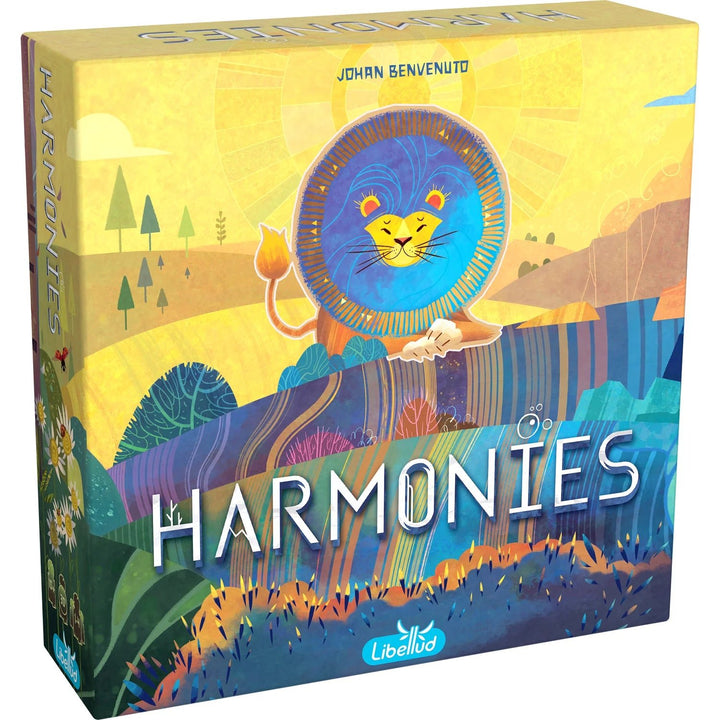
£27.99
£33.99
Description In Harmonies, you will create beautiful landscapes by placing colored tiles. These tiles will create territories for animals and will bring them in to settle in your tiny world! Tactically combine your landscapes and animals to earn the most… read more
Looking for something a bit different?
I would definitely recommend Harmonies to all, but if you are intrigued by the abstract nature-themed game but want to try something a bit different, why not look at Cascadia? Lay hexes to build out different terrains whilst placing animals in different scoring patterns.
Not interested in the nature theme but enjoy the tile drafting and placement mechanic? Why not look at Azul Queens Garden?
If you want an awesome game about animals and not an abstract tile placement game, how about Ark Nova? This is a fantastic strategic game about building a Zoo that combines a great experience for visitors and focuses on supporting conservation projects around the world. This is another fantastic game!
Check out our full collection of board games right here at Gathering Games.
